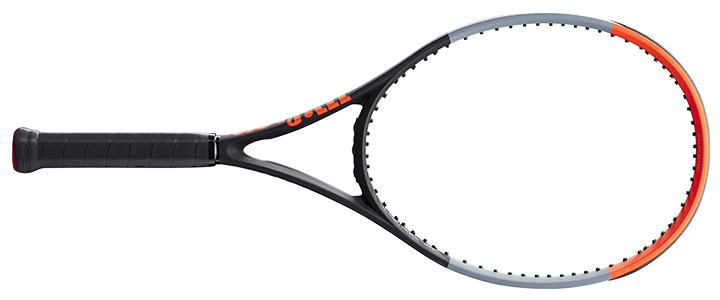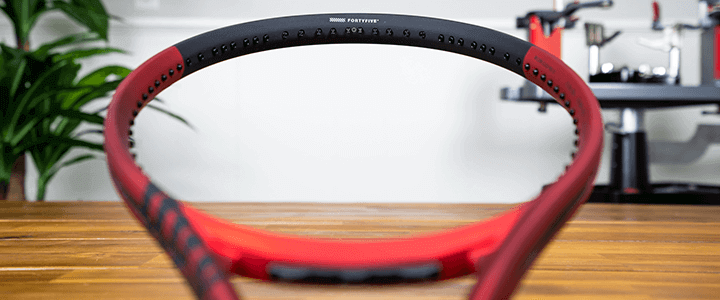Check out my custom vibration dampener
Wilson Clash 100 Pro v2
Review & Playtest
We hope you love this article. Just so you know, TennisCompanion may collect a small share of sales from the links on this page to help keep this site running. Learn more. Disclosure: Wilson gave me this frame to evaluate, but they did not pay me to write this review or influence its contents.
Updated for 2022, the Wilson Clash 100 Pro v2 seeks to build on the first generation’s popularity with an intriguing update that includes a new 16×20 string pattern to enhance control.
However, beyond the sting pattern, Wilson didn’t stray too far from the original design’s specs opting for a moderate refinement they hope will capture the attention of existing users while pulling in a new audience that may have held off last time around.
To help you decide if the Wilson Clash 100 Pro v2 aligns with your style of play, I’ll share my thoughts on the racquet’s design, ideal string setup, and on-court performance in this review. I’ll also provide my take on whether you should spend your money upgrading for existing first-generation users.
| Popular Clash Models |
| Wilson Clash 98 v2 |
| Wilson Clash 100L v2 |
| Wilson Clash 100 v2 |
| Wilson Clash 100 Pro v2 |
| Wilson Clash 108 v2 |
To keep the review as concise as possible, I won’t dive into the specs, technical features, or alternative racquet you might want to consider. If you’d like to explore those, I’d encourage you to check out my complete Wilson Clash 100 Pro v2 product page.
If you’re interested in this racquet, you might also want to check out my reviews on the Wilson Clash 98 v2, Clash 100 v2, and Clash 108 v2, one of which might be a better fit for you.
Article Contents
Click below to jump to a section
Tap below to jump to a section
Design
Strings & Tension
Performance & Ratings
Groundstrokes
Volleys
Serves
Returns
Summary
Upgrade Advice
New to TennisCompanion?
Create a free account and explore my latest videos below
Design

As part of the release of the second generation, Wilson completely reworked the Clash 100 Pro’s paint job, which is a substantial departure from the previous model.

Although a racquet’s design doesn’t affect its performance on the court, it’s often a serious consideration that influences purchases, so I’m happy to see Wilson went with a refresh here.

There was nothing wrong with the original model’s design. However, I didn’t feel it was too inspiring as it stuck with the company’s “uncontaminated design” features, which were consistent across performance models except for an accent color.

For the Clash 100 Pro v2, Wilson treats players to a dark red matte paint job with black accents. Although I’m not typically a big fan of the color red, I think they nailed it with this update.
The racquet’s finish is matte, but it has a subtle metallic shine that’s more prominent in the light. Like the previous generation, the paint is velvety smooth to the touch and reminiscent of rubber.

Wilson’s official name for the paint is an anodized elastic finish, which I think looks great on their racquets. The material’s durability struggled in the past, but I’ve found it to hold up pretty well, and I hope Wilson continues to refine it.

Starting at the racquet’s throat, you’ll find one of the frame’s most unique design features, a debossed logo that’s stamped direction into the side of the frame. It gives the throat a unique texture that stands out from the crowd, although I’m curious what considerations Wilson had to make to ensure consistent performance from each side of the frame.

Opposite the Clash logo, you’ll find the Wilson logo wrapping the edge of the racquet along with the frame’s model and stiffness rating, which highlights their emphasis on its comfort.

At three and nine o’clock on the racquet’s head, Wilson continues with the matte red finish and prints the frame’s specs on the inside edge of the frame. I prefer to see these printed on the frame rather than having to dig them up online, so I’m happy to see them there because the original model didn’t include them.

Wilson goes with matte black for the top hoop and highlights the frame’s FortyFive construction in silver.

At the very bottom of the racquet’s handle, you’ll find a red butt cap with a black Wilson logo, which looks similar to the prior model. However, I would have loved to see Wilson print the grip size directly on the cap, so players don’t have to hunt for it.
It’s worth noting that you can find the grip size on the inside of the handle if you pop off the trap door, but most players aren’t aware.
Strings & Tension

Wilson recommends stringing the Wilson Clash 100 Pro with Luxilon Alu Power and a suggested tension range between 50 – 60 lbs (22.68 – 27.22 kg).
Luxilon Alu Power is a high-quality polyester tennis string that emphasizes control, spin, and feel. I think it is an excellent pair with the racquet, especially considering the strong intermediate to advanced players likely to use it.

I strung 17 gauge or 1.25 mm Luxilon ALU Power for my playtest at 55 lbs (24.95 kg), which is the halfway point between Wilson’s recommended tension, giving me room to adjust up or down in the future based on the racquet’s performance.
If you’re purchasing the Wilson Clash 100 Pro for its low stiffness or RA rating, then I’d urge you to consider a different type of string or, at the very least, a hybrid string setup.
Luxilon Alu Power is fantastic and one of my picks for the best, but it’s stiff, which can cause arm discomfort even within a high-comfort racquet like the Clash.
Performance & Ratings

To help you make the most informed decision regarding the Wilson Clash 100 Pro, I’ve shared some notes about my playtest setup below, so you know exactly how I approached this review.
Although I’m always striving to review the tennis racquets I evaluate objectively, I recognize my unique experience, skillset, and attributes influence my thoughts. If you’d like to dive a bit deeper, you can learn more about me here.
| Main Strings | Luxilon ALU Power (1.25 mm) |
| Cross Strings | Luxilon ALU POwer (1.25 mm) |
| Mains Tension | 55 lbs / 24.95 kg |
| Crosses Tension | 55 lbs / 24.95 kg |
| Forehand Grip | Semi-Western |
| Backhand | Two-handed |
| Grip Size | #3 – 4 3/8 |
| Grip | Wilson Pro Performance |
| Overgrip | Wilson Pro |
| Weight | 165 lbs / 74.84 kg |
| Height | 6’0″ / 1.83m |
Like all my racquet reviews, I evaluated the Wilson Clash 100 Pro across a set of twelve different performance criteria.
I further detail my ratings in the following sections, including groundstrokes, volleys, serves, and returns.
Groundstrokes

The Wilson Clash 100 Pro v2 excels from the baseline with impressive power and reliable spin that results from the frame’s construction, midrange 100 in² (645 cm²) head size, and solid 10.9 oz (310 g) unstrung weight.
There’s no doubt the racquet takes a bit more energy to swing, so you’ll have to consider that factor if evaluating this frame. However, the weight is right up my alley, and I found it to move through the ball efficiently and remain stable, even when facing a heavier shot from an opponent.

The racquet gains an extra cross string compared to the original model, which slightly stiffens up the string bed and flattens out the ball’s trajectory. However, it doesn’t sacrifice much spin.
The result is improved control, which is a good move by Wilson and better complements the frame’s power. Combined with the racquet’s updated construction at the tip of the hoop, the second generation feels more reliable than the first.

Regarding slice, I thought the Wilson Clash 100 Pro v2 performed well and felt the tightened up string bed also translated to an improved, more consistent response.
The only tradeoff I felt the racquet makes with the tighter 16×20 string pattern is comfort, which is slightly lower than the prior, but still top-notch and remains an excellent reason to pick up this model.
Volleys

Hitting volleys, the Wilson Clash 100 Pro v2 is mostly fantastic, but it lacks a bit in the feel department.
I found excellent precision with the frame and felt once again that the updated 16×20 string pattern led to an improvement here. My shots tracked accurately, and I consistently hit my spots, which helped instill confidence at the net.
I also thought the racquet delivered solid pace behind my volleys, which helped me put more balls away and put extra pressure on my opponents to react quickly.

Its heavier weight may cause some maneuverability issues for intermediate players who are still developing their strength and technique, but it remains approachable with a head light balance.
Regarding feel at net, I thought the racquet felt a bit muted, and touch volleys didn’t come as easily, but this is an area that often improves the more time you spend with a racquet.
Serves

On serves, I enjoyed hitting with the Wilson Clash Pro 100 v2. It’s meaty enough to help deliver extra weight behind a serve, but it’s not overwhelming to swing.
Although I mostly enjoyed the tighter 16×20 string pattern, serving is one area where I felt it lacked a bit of bite. Combined with the extra work it takes to swing the racquet fast to generate spin, it will likely result in a bit less action on the ball for some players who are used to the original model.

On the flip side, I thought the racquet delivered solid precision and a mild improvement over the prior model. Ultimately on serves, I think the newer model makes the right tradeoff for the players I expect will find this racquet appealing.
Returns

On returns, the Wilson Clash Pro 100 v2 offers a reliable performance that can withstand the pace of a heavy serve.
It’s maneuverable enough to respond to quickly bigger serves while also having the stability to avoid getting pushed around, which ultimately translated to added control in my replies.

I also appreciate the racquet’s slightly larger sweetspot compared to the prior model, which along with the mid-range head size, affords me extra margin for error and improved consistency.
Summary

Strong intermediate to advanced tennis players who demand comfort but don’t want to give up too much power will be right at home with the Wilson Clash 100 Pro’s all-around performance.
It excels from the baseline allowing players who can swing it confidently to hit a commanding ball while retaining plenty of control in a comfortable package that’s easy on your arm.
I’d encourage beginners and early intermediates to steer clear of this frame, which will be too demanding. It’s also not ideal for players looking for maximum free power and spin. However, the alternatives will undoubtedly lead you to less comfortable racquets, so it’s a tradeoff you’ll need to consider.
| Popular Clash Models |
| Wilson Clash 98 v2 |
| Wilson Clash 100L v2 |
| Wilson Clash 100 v2 |
| Wilson Clash 100 Pro v2 |
| Wilson Clash 108 v2 |
Upgrade Advice

Overall, I’m a fan of the updated Wilson Clash 100 Pro v2, but I wouldn’t flat-out recommend every player upgrade because it depends on your priorities and preferences.
Who Should Upgrade
For starters, I’d only encourage you to upgrade to the Wilson Clash 100 Pro v2 if you enjoyed the unique feel of the first version, which hasn’t changed dramatically.
If so, players who felt the original model lacked control and a consistent response will be the best candidates for an upgrade.
The latest generation moves from a 16×19 to a 16×20 string pattern, which stiffens up the string bed, lowers the trajectory or flight path of the ball, and slightly reduces power, which subsequently lends itself to more control.
Combined with the improved construction of the frame at the tip of the hoop, I think the racquet showcases a marked improvement in precision over the original racquet.
However, it does come at a small cost, which is a bit less spin, and a slightly less forgiving feel. I have a semi-western forehand grip and rely heavily on topspin, but I still prefer the latest model because I think the gains outweigh the losses.
With that said, if my comments resonate with you, I’d still recommend you consider demoing the racquet, which will help ensure you’re confident in your decision. Wilson has an excellent demo program if you’re interested in giving it a shot.
Who Shouldn’t Upgrade
If you’re happy with your existing Wilson Clash 100 Pro v1 and don’t feel it lacks control, enjoy the open 16×19 string pattern that helps maximize comfort and spin, and lends itself to a bit of extra power, then you may want to hold off on switching.
The original model is a solid frame that will undoubtedly remain the superior option for some players, so you shouldn’t feel like you need to take the plunge and spend the extra money.
Of course, if you don’t have a strong feeling one way or the other and enjoy the look of the latest generation, then there’s nothing wrong with upgrading either, especially if you dig the new paint.
I believe most people who are perfectly satisfied with the first generation will still enjoy hitting with the latest model, so if the upgrade is tempting, I don’t think you’ll be disappointed.
Wrapping Up

When it comes to modern players’ racquets, there is no shortage of options for players to consider, but the comfort of the Wilson Clash 100 Pro v2 is a cut above the rest.
For that reason, I’d expect more players to adopt the frame, especially those who played competitively at a younger age and are looking to stick with the game but want to protect their arms.
Hopefully, this review helped shed some light on what to expect from the Wilson Clash 100 Pro v2. If you have any follow-up questions, please don’t hesitate to post a comment.
Play Better Tennis
Improve your game alongside our community of tennis players
Why join?
Discussion Boards
Join the conversation with other members of the community.
5 Point Friday
Read our weekly recap of the 5 most interesting things we dig up in tennis.



Leave a Reply
Want to join the discussion?Feel free to contribute!